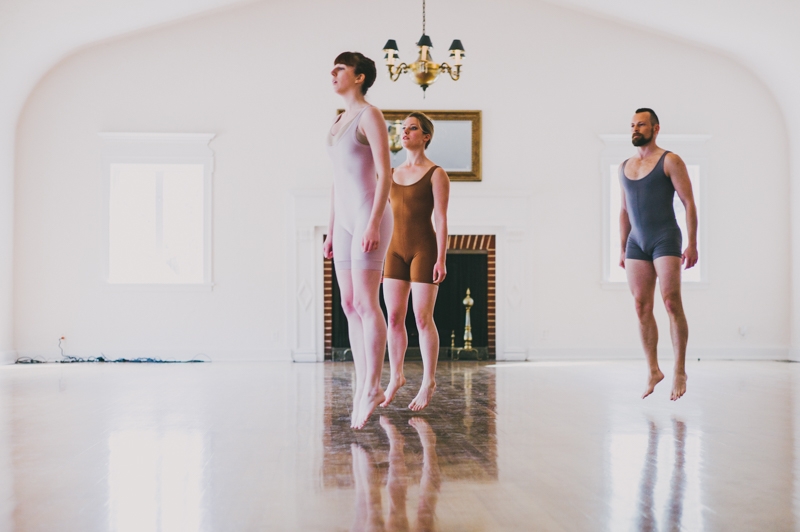loveDANCEmore, a series of community events showcasing the dances and dancers of Salt Lake City, staged a one-day performance at the Memorial House.
loveDANCEmore @ Memorial House 03.22
Art

Song for One or More opened up the loveDANCEmore performance on 03.22. Photo: Tyson Call
loveDANCEmore, a series of community events showcasing the dances and dancers of Salt Lake City, staged a one-day performance at the Memorial House. The day featured three performances of group dances choreographed by loveDANCEmore founder Ashley Anderson, Repertory Dance Theater member Efren Corado Garcia and Porridge for Goldilocks facilitator Amy Freitas. The Memory Grove Park reception center—a space that hardly ever presents dance—provided an intimate, slightly colonial setting. The room was almost anachronistic, with wooden floors, windows across the sides, a fireplace, dim yellow stage lights and unpretentious chandeliers. The small audience shuffled in their chairs, eager for the latest installment by loveDANCEmore, which, since its inception in 2010, has only continued to uplift and bring together the Salt Lake dance community.
A recording of a slow, rhythmic clanging begins to fill the room, introducing us to Garcia’s “Song for One or More.” Three dancers—Lauren Curley, Amy Falls and Jeffrey Kent Jacobs—make subtle, synchronized movements to the music. The bell sounds begin to build and layer into a dissonant canon, and the dancers’ movements become more fluid and aware. The dance feels cerebral—it’s a cyclical, almost ritualistic visualization of music, stripped to its most elemental rhythms and timbres. The progression of the dancers’ movements remind of a clock’s unstopping, annular ticking, or the steady swing of a pendulum. The choreography alone doesn’t particularly compel, but it excels at grounding the sonic discord through its careful embodiment of the music.
Anderson’s “witch dance,” originally performed as a duet, was expanded to incorporate more dancers and further its methodical study of rhythm and pattern in movement. The performance features Alex Bradshaw, Lehua Brown, Ching I Chang, Amy Freitas, Katie Meehan, Alysia Ramos and Erica Womack. All of the women are clothed entirely in black. One at a time, they dance, until a loop of the bouncing, grooving introduction to Simon and Garfunkel’s “Cecilia” begins to play. The dancers start to move together, leaping through an energized combination of each individual’s previous movements.
When the song’s vocals begin, however, the dancers continue in the same pattern, only muted. Just the chorus plays, that infectious hook made up of part jubilation, part anguish: “Cecilia, you’re breaking my heart.” There are no more leaps or energetic kicks now, only slow turns and quiet, controlled steps. The combination continues to each corner of the room, but toward the end of this spellbinding reverie, Chang breaks apart from the group, running dazedly and leaping erratically. Freitas rushes after her and subdues her, picking her up and bringing her back to the group. They smile and return to their celebration. When the music comes to an end, all we hear are the dancers’ steps and breaths. The dancers are as enchanted as we are by the slow, steady accumulation of movement, though the breakaway and mini-duet toward the end of “witch dance” made me want to experience more of a narrative aspect, particularly with so redolent a song as “Cecilia.”
The second number, “Porridge for Memories,” helped to tie the night’s performance and the community-centric loveDANCEmore together. The work was sentimental—it felt candid, as though a work in progress, still rough around the edges—but as the dance progressed and melded with other art forms, it became clear that the roughness was integral in shaping and enhancing what the dance conveyed to its audience.
Choreographed by Freitas and performed by the multidisciplinary group Porridge for Goldilocks, the work began with dancers dressed in regular garb: Katherine Adler, Keanu Forrest Brady, Brooklyn Draper, Joaquín Galván, Joshua Mora, Monica Remes, Tanja London and Emma Wilson. London, in sweats and sneakers, begins to move: a limb stretches out, the rest of her body catches up, repeat. Two other dancers join in with their own iterations of this back-and-forth extension and retraction. Soon, drums, performed excellently by Wachira Waigwa-Stone, join in. As the percussion begins to reverberate and echo throughout the space, the other dancers come to life. As the music becomes more melodic, the movements become more fiery and emphatic. Duets form. The dancers share in each other’s space, expressing intimacy and forwardness, working to complement, parallel, repel and propel one another.
The drums stop. A soloist emerges. She sings, casually yet longingly, reaching and filling the empty spaces of the room with a classic rendition of “Dream a Little Dream of Me.” Soon after, spoken word artist Nick Shifrar walks through a door, holding open a black book. He is assured and effusive, reciting as a single dancer moves. “One day we will be nothing,” he says. So he urges us to rise, to bloom, to boom, to blossom. His words are an ode to a lover, to many others, to life, to dance, all made into one and likened to magnetic fields and stars. We step on toes, he admits, but he explains that that is what grace is. His poetry cements the dance together. As he leaves, the fiery drums course once more, and the dancers begin to greet one another, grinning, twirling, pulsating. Their movements become more palpable because we realize that they play on the improvised, on memory, on relationships and on life—sometimes messy and clumsy, a little frayed, yet earnest and genuine—a series of moments, one after another, sometimes lonely, sometimes frantic, always yearning.
For more information and upcoming events, visit loveDANCEmore’s website.











